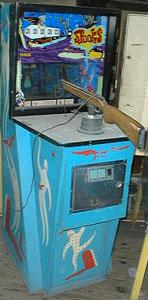
|
Description: Spooks, Williams #365, 2/69, black light, electronic sound for witch, skull and bullseye flash targets. There are three periods in this game for each of the three target (scene) types. The operator can adjust the number of times (periods) the player goes through the three scenes to either twice or three times. The time and shots are not adjustable. Game uses the Remington 514 model 22 short gun, like most Williams gun games. Please contact me if you have this game for sale at cfh@provide.net This was Williams' first run at using electronic sound in pretty much any game. The sound board makes four different sounds (actually five sounds, but one sound is not used), a sound for each of the three "scenes", plus and extra period sound. The Bullseye Flash makes a low pitch sound, hard to hear. And you only get that one low "beep" with a hit to the Bullseye Flash. After that hit the scene changes, and the Skull target appears. The Skull has a medium pitched sound with a hit (a curtain hides the skull target until it is activated in the game.) The Skull will rise and fall, giving the player plenty of time for many hits. Once the Skull falls, the Witch scene starts with witch movement across the top of the backdrop. You have one chance to hit the Witch - if you miss, the Witch scene is over, and it moves to the beginning (Bullseye Flash or end of game.) But hit the Witch and she reverses direction. The object is to keep hitting her, making her go back and forth in quick progression. This will go on forever or until you miss! The sound for the Witch is a higher pitch "beep." Basically the sound board is making the same sound for the three scenes, but at three different pitches. If you get past the replay score, you get an additional period of the three scenes, and the game makes five quick sounds in sequence to signify an extra period. Note the 1969 Williams Phantom gun game, it is essentially the same game as Spooks, in a slightly different format. Instead of having three scenes with a separate target for each scene, Phanton took the target elements of Spooks, and combined them into a single scene (using a shot counter, which Spooks did not utilize.) The theme is essentially the same in Phantom (Halloween spook house), just you have three targets to shoot, all at the same time. A spinning wheel was used instead of the Bullseye flash target (a similar target idea), but it's has the back-and-forth Witch and the moving Monster, just like Spooks.
Spooks Sound Board. Sound Board Connector Pinout:
Note you can modify a switch at Index C position of the score motor (wht-red and grn-red) to make the sounds longer. If score motor switch #iC is permanently closed, it makes the "hit" sound for the Bullseye Flash and the Skull longer and more pronounced. The Witch uses the Sound relay (aka "Tone Delay relay") that is mounted above the sound board, and this has a 150ohm resistor and 100mfd 50v cap to keep this relay energized a bit longer. This sound relay activates from the Witch Target Hit relay. Changing this cap to 2200mfd 50v gives a slightly longer Witch hit sound (recommended.) There is one last sound produced, and that is activated thru the Extra Period relay and a Control Impulse switch on the score motor. It makes five quick tones if the player scores an extra period. If you are unimpressed with the electronic sounds, a switch can be added to the 10pt relay that goes to a 50v bell (you install.) I don't recommend both the bell and the electronic sound though, pick one or the other!
Spooks Curtain.
Spooks Nylon Curtain/Skull Gear.
New Spooks Sound Track. The idea uses a four button MP3 player that runs on 5 or 6 volts, such as the one from Electronics123.com. This is a nice MP3 player with 6vdc input voltage, four buttons, 3watt amp, and 4meg of built in storage (no MicroSD card needed for this application.) For power we can use the Blk-Wht wire on the Lock relay (which powers the Period lights) and the Yellow wire (transformer center tap) as our as 6vac feed. A bridge rectifier/2200mfd cap converts the 6vac to 6vdc for the MP3 player power, and the capacitor smoothes the DC wave form across the DC bridge lugs. Then a modified Midway Haunted House sound track plays during the Bullseye Flash scene. A normally open switch is added to the Flash relay that triggers the K1 switch on the MP3 player and runs the background sound track (0001.mp3). Note if the player does not hit the bullseye flash target, the scene does not end. So this sound track should be long enough to support a bad player. After the player hits the Bullseye Flashing target, the Flash relay releases, and the Skull Target Run relay energizes. Again an added normally open switch to this relay closes the K2 mp3 player switch, and the Monster sound track (0002.mp3) will play. Note the Skull scene only takes about 10 seconds for the player to hit the skull as many times as possible. Hence a only a short sound track is needed. After the Skull scene is over, the back-and-forth Witch moves using the energized Witch Target Run relay. This scene could go on forever, if the player is skilled to keep hitting the witch. One miss, and the Witch scene is over. Of course the K3 mp3 player switch is triggered via an added normally open switch on the Witch Target Run relay. This plays the Witch sound track (0003.mp3). This sound track needs to be rather long, because of the potential of a good player repeatedly shooting the Witch. Lastly a read.cfg text file containing '1' needs to be on the MP3 player, along with these three sound files. This config text file tells the MP3 player to play the triggered sound as long as the associated switch is kept closed. Since the three sound files are MP3 format, they do not occupy much space - there's plenty of room on the MP3 player without using a MicroSD card. Also should note that the Electronics123 MP3 sound board's K1-K4 switch triggers all trigger off a common reference. So that means you only need one wire going to the Mp3 sound board from the added relay switches - the other switch tabs are all tied together, and a single wire tied to the common Kx reference on the MP3 sound board. The next sound that could be added is a gun shot sound. Note I did not add this sound, the game seems to be pretty "sound rich" with the above added Haunted House sounds. But if desired, a normally open switch added to the Trigger relay could trigger a gun shot noise. A separate MP3 player and speaker would be needed for this. An inexpensive MP3 player for this is the DY-SV17F, available at Amazon and costs about $5. It has built-in 4mb RAM, enough to hold the above linked gun shot MP3 file (no microSD card needed.) Be sure to set this device to "I/O Independent Mode 1", which means Con1 and Con2 pin must be permanently grounded. Then Tx/io0 pin is connected to an added switch on the Trigger relay. This will play the 00001.mp3 file (the gun shot sound.) The power pads go to the bridge recitifier, just like the other MP3 player installed above. And obviously the speaker pads go to a separate speaker. Note you must use a separate speaker for the MP3 board. Do not try and use the existing speaker(s) in the game or it will destroy the MP3 boards' amplifiers. And to answer your question... yes you could use the above Electronics123 sound board, and use the fourth sound track for the gun fire. But the issue with that is it will interrupt the background sound every time you pull the gun trigger. Hence it's better to have a dedicated sound board just for the gun shot sound. Doing that will overlay the gun shot sound without interrupting the background sound. Note the stock Spooks sound board is still kept in the game with the MP3 sound modification(s). That means any target hit will make a "beep" sound, which is a nice touch. Alternatively you can use a bell for target hits too. But either way, it is useful to have a "hit noise" because when the desired target is hit you get a dedicated sound, where the MP3 players do not react to a target hit (it just plays through the particular scene.)
|
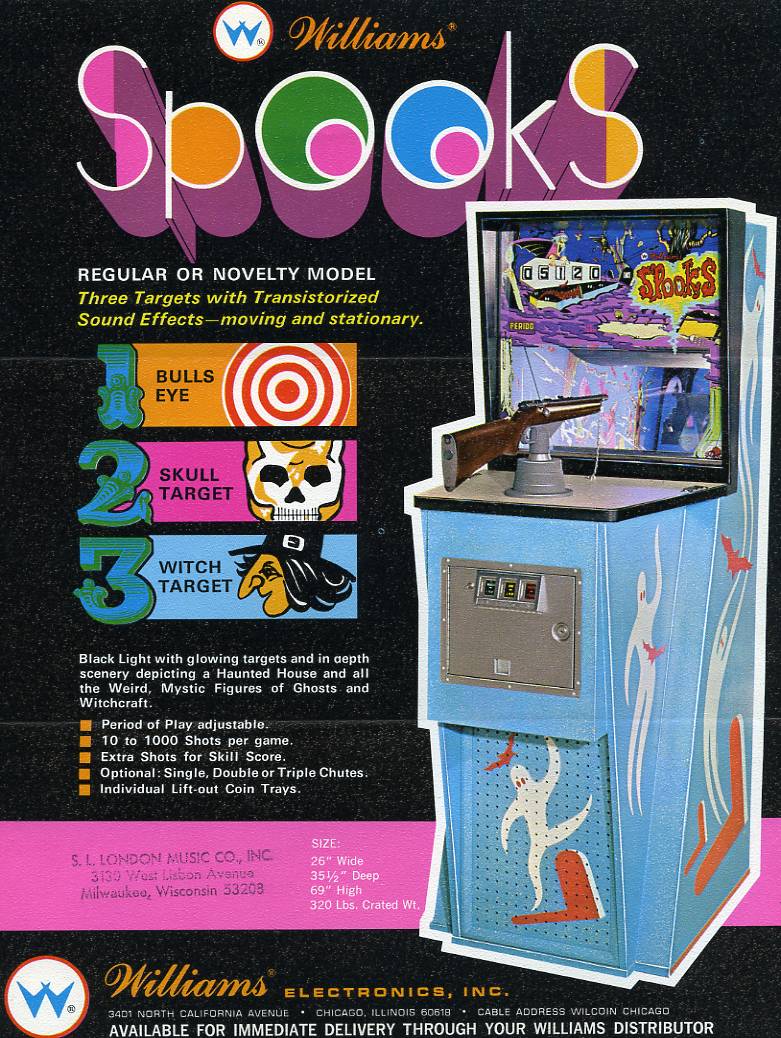

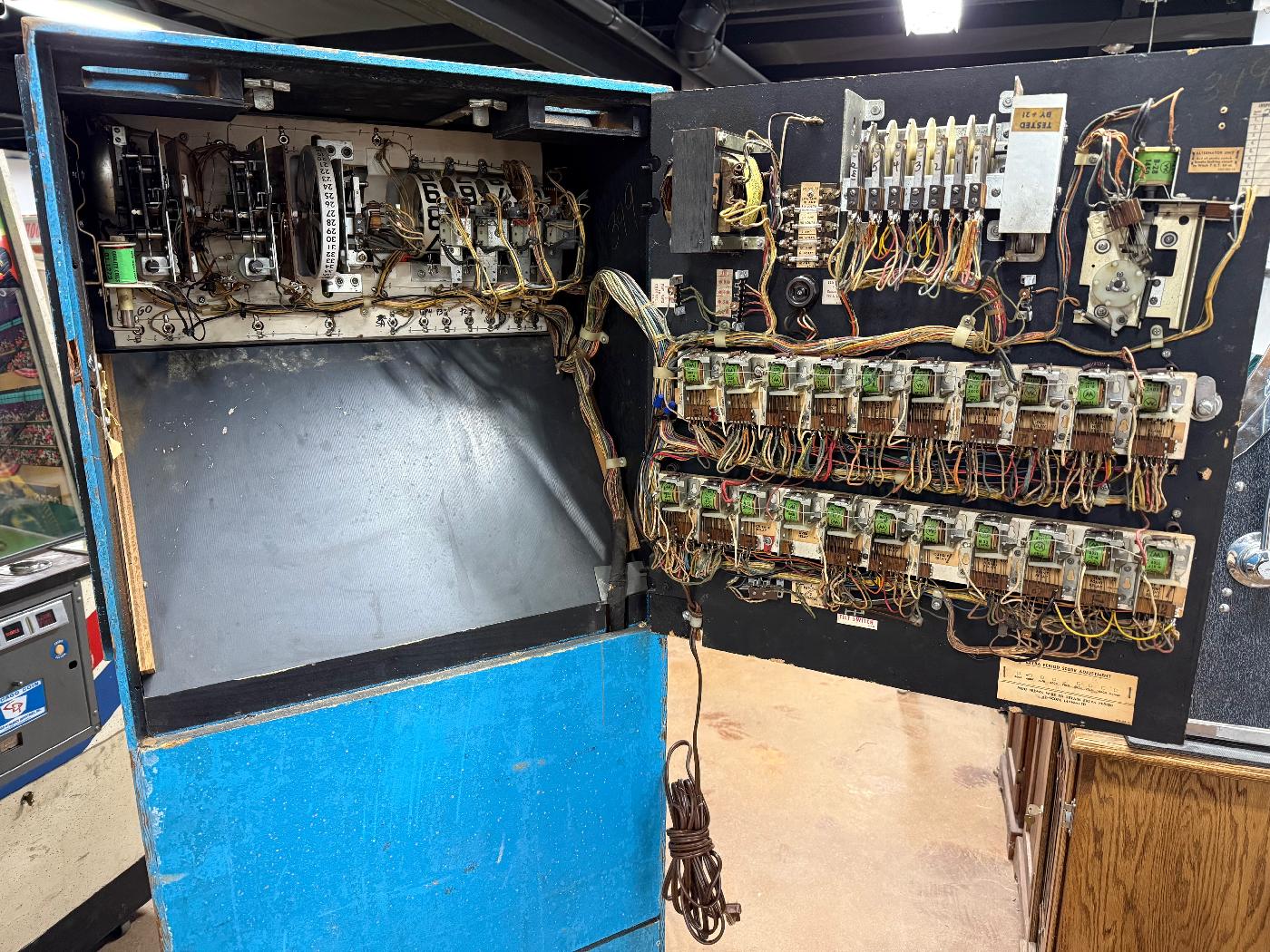
The Skull movement nylon gears. The small gear was broken where it meshes with the large gear. By reversing the position of the gear,
new virgin teeth are used, and the gear is saved.
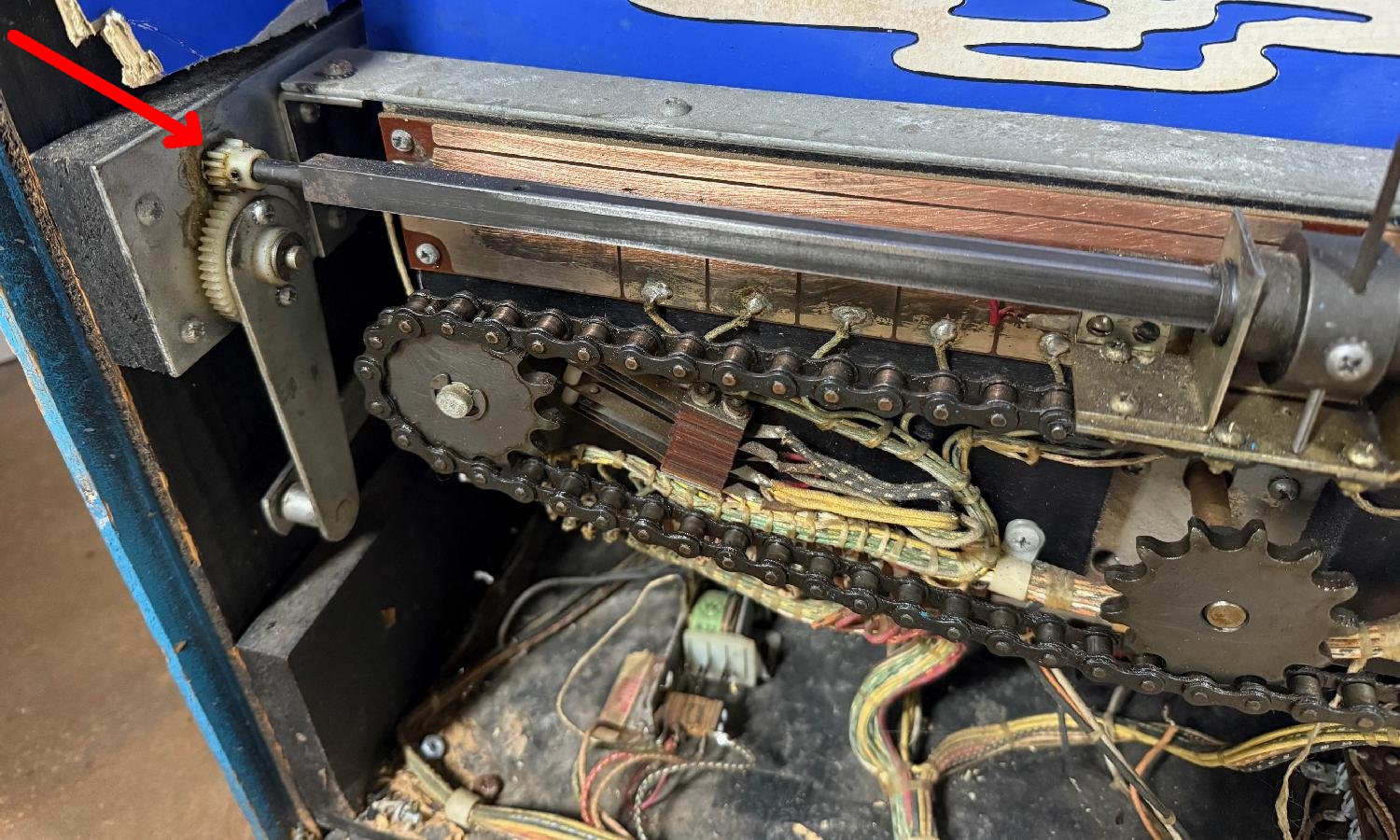
The sound board and sound relay ("Tone Delay Relay") used in Williams Spooks. The capacitor holds the relay in, for a longer Witch sound tone.
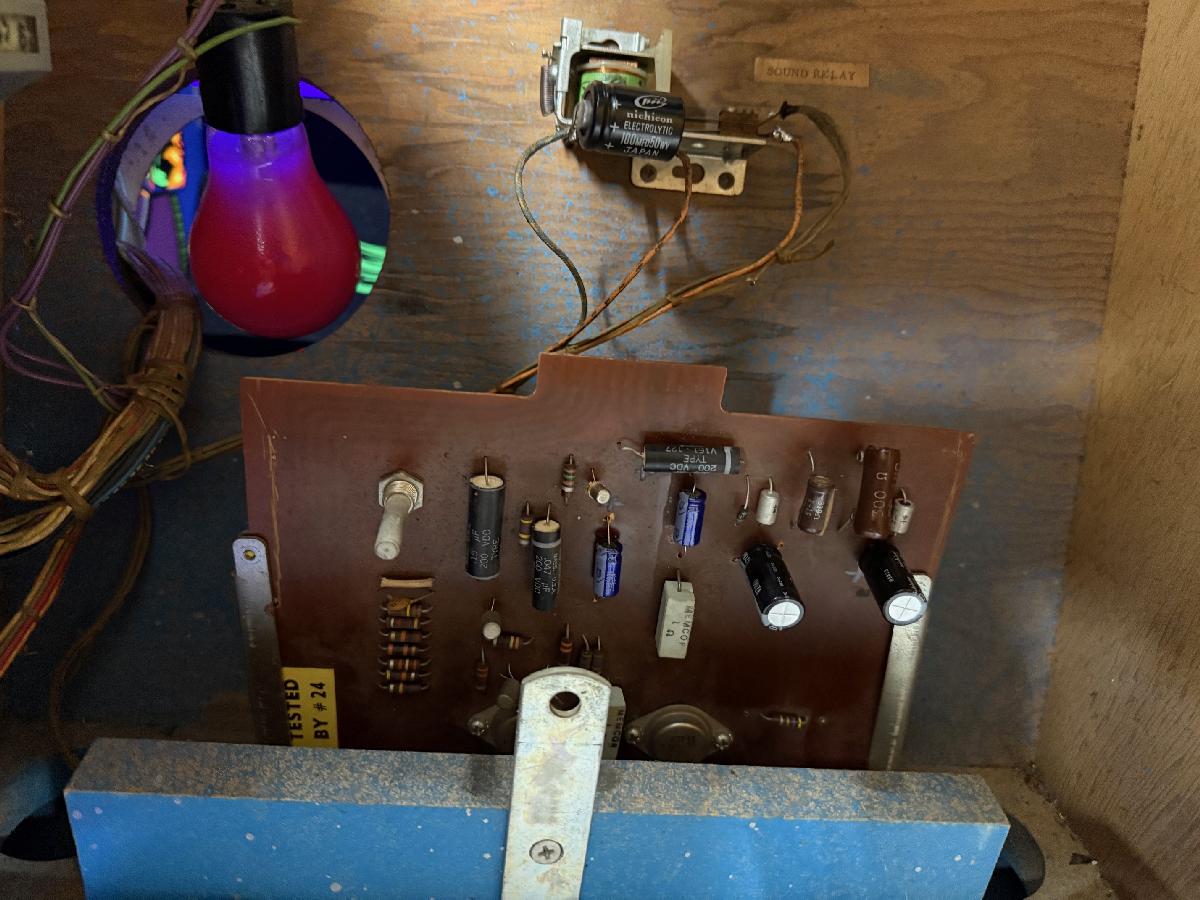
Added MP3 player that plays separate sounds for the Bullseye Flash, Monster and Witch scenes.
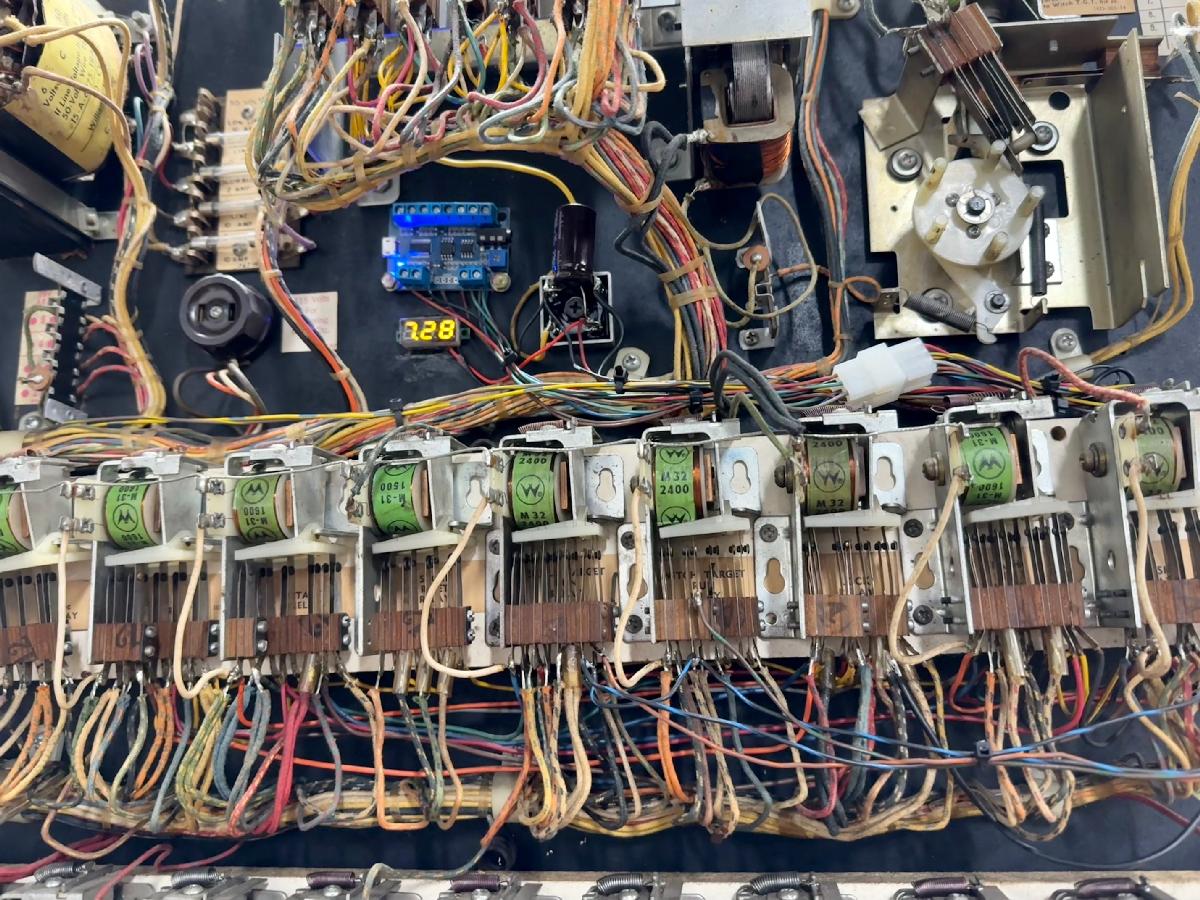
|
* Email the collector cfh@provide.net * Go to the EM Arcade History index * Go to the Pinball Repair/History index |